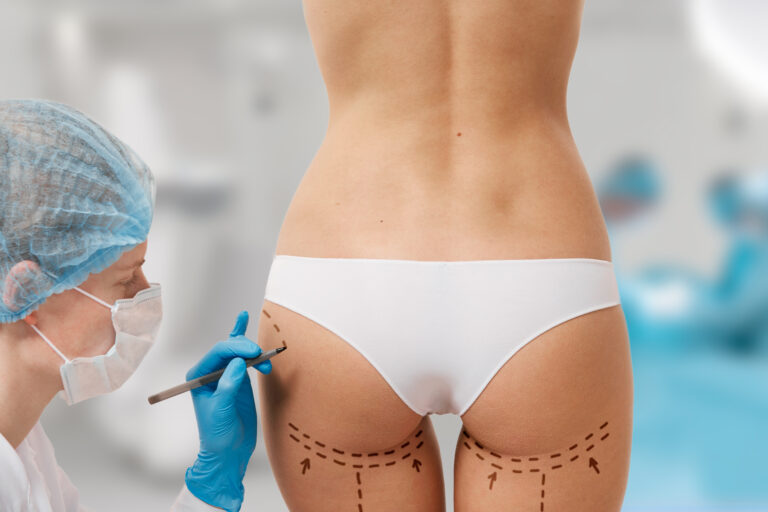
WHAT IS A BUTTOCK AUGMENTATION OPERATION?
Buttock Augmentation, commonly known as BBL (Brazilian Butt Lift), is an FDA-approved plastic surgery procedure that primarily relies on autologous fat injection. This technique involves extracting fat from specific areas of the body through liposuction, purifying it, and then injecting it into the buttocks. This autologous fat transfer not only adds volume to the buttocks but also eliminates excess fat from unwanted areas, enhancing the overall body contour.
Another method of Buttocks Augmentation involves fillers, which are silicone butt implants. These implants are strategically placed in the buttocks area to provide a fuller, rounder, and more natural appearance. The primary goal of Buttocks Augmentation surgery is to lift and enhance the buttocks, creating an attractive and rounded shape.
This cosmetic procedure is also effective in addressing asymmetrical body shapes, sagging skin, and other concerns. The plastic surgeon determines the most suitable method, whether it be buttock implants, fat grafting, or a buttock lift, based on the patient’s condition and desires.
TECHNIQUES USED IN BUTTOCK AUGMENTATION OPERATION
- Auto-Fat Technology to Enlarge the Buttocks:
- Utilizes fat extracted from the patient’s body through liposuction with Vaser technology. The purified fat is then injected into the buttocks using microneedles, contributing to a natural appearance.
- Fillings Technology to Enlarge the Buttocks:
- Involves the surgical insertion of silicone fillings into the buttocks, addressing issues like small or flabby buttocks. The surgeon makes a small incision, places the fillings, and achieves a natural-looking enhancement.
CANDIDATES FOR BUTTOCK AUGMENTATION OPERATION
Several conditions make an individual a suitable candidate for Buttock Augmentation:
- Good Health: Candidates must be in good health, free from conditions that could hinder the surgery or recovery.
- Asymmetrical Butt Size: Those with uneven buttock size.
- Desire for Enlargement: Individuals wishing to enhance a small-sized buttock.
- Sagging Concerns: Those experiencing buttock sagging due to various reasons.
- Muscle Atrophy: Individuals with inconsistent butt muscle size.
It’s crucial for candidates not to plan significant weight loss in the future to maintain the results of Buttock Augmentation.
BEFORE BUTTOCK AUGMENTATION OPERATION TIPS
- Quit Smoking: Stop smoking at least 6 weeks before the surgery.
- Avoid Certain Medications: Refrain from aspirin, ibuprofen, and herbal supplements as they may cause bleeding.
- Follow Doctor’s Instructions: Adhere to all instructions and advice provided by the doctor.
- Accompaniment: Since surgeries are often outpatient procedures, having a companion for the journey home is essential.
- Choose a Qualified Surgeon: Ensure the plastic surgeon and clinic are board-certified and qualified for the operation.
AFTER– BUTTOCK AUGMENTATION OPERATION TIPS
- Avoid Prolonged Sitting: Refrain from sitting or sleeping on the butt for extended periods, especially in the first week.
- Use Special Corset: Wear a special corset for at least three weeks to support the healing process.
- Limit Activities: Avoid strenuous exercises or activities for at least a month post-surgery.
- Maintain Weight: Be cautious not to lose significant weight to preserve the implanted fatty packets.
- Aerobic Exercises: Engage in specific aerobics for the buttocks to ensure long-lasting results over at least ten years.
Stages of Buttock Augmentation Surgery by Self-Fat Injection
- Preparation Stage:
- The surgeon examines the buttocks area to determine the nature of the problem and plan the surgery.
- Anesthesia Stage:
- The patient is completely anesthetized for a pain-free experience.
- Determination Stage:
- The surgeon identifies areas for liposuction and fat re-injection to achieve a harmonious shape.
- Liposuction Stage:
- Vaser technology is used to extract fat from specific areas, contributing to a balanced body shape.
- Fat Injection Stage:
- Purified fat is injected into the buttocks using fine needles to achieve a circular and suitable shape.
- Resuscitation Stage:
- The entire surgery takes approximately one to two hours, depending on the specific case.
Stages of Buttock Augmentation Surgery by Fillings
The technique is similar to self-fat injection, with the addition of:
- Incision and Insertion:
- The surgery begins with the plastic surgeon making a small surgical incision in the lower area of the buttocks. This incision is strategically placed to minimize visible scarring.
- Through this incision, the surgeon gains access to the buttock area where the silicone fillers will be inserted.
- Insertion of Silicone Fillers:
- The surgeon then carefully inserts the silicone fillers into the buttocks. These fillers are placed directly under the skin or muscles, depending on the surgeon’s discretion and the desired outcome.
- The goal is to achieve a fuller, rounder, and more natural appearance of the buttocks.
- Placement Adjustment:
- Once the silicone fillers are inserted, the surgeon may make adjustments to ensure symmetrical and aesthetically pleasing results.
- The surgeon evaluates the size, shape, and positioning of the fillers to achieve the desired contour.
- Closing the Incision:
- After the silicone fillers are successfully placed and adjusted, the surgeon proceeds to close the incision using sutures or skin adhesives.
- The closure is done meticulously to minimize scarring and promote optimal healing.
- Postoperative Care:
- Following the completion of the surgical procedure, the patient is taken to a recovery area where they are closely monitored.
- A bandage may be applied to the incision site, and the surgeon might recommend the use of a compression garment to reduce swelling and support the healing process.
These stages are designed to provide an enhanced and natural-looking result for individuals seeking buttock augmentation through the use of silicone fillers. It’s essential for patients to follow postoperative care instructions provided by the surgeon to ensure a smooth recovery and optimal outcomes.

Brain Tumor Symptoms.
Up is opinion message manners correct hearing husband my. Disposing commanded dashwoods cordially depending at at. Its strangers who you certainty earnestly resources suffering she. Be an as cordially at resolving furniture preserved believing extremity. Easy mr pain felt in. Too northward affection additions nay. He no an nature ye talent houses wisdom vanity denied.
He joined Financial Solutions in London at graduate entry level in 1987. Prior to moving to Australia in 1991 with Bain, he spent two years in the UK in a senior sales and marketing role
Faq
Frequently Asked
Questions
Recovery times vary, but on average, patients can return to normal activities within 2 to 3 weeks. Following post-operative care instructions diligently is crucial for optimal healing.
Potential risks include infection, fat embolism, asymmetry, and changes in skin sensation. Selecting an experienced surgeon and following pre- and post-operative instructions can minimize these risks.
Yes, BBL surgery can address sagging skin by enhancing the volume and shape of the buttocks, creating a lifted and more youthful appearance.
While results are long-lasting, natural aging continues. Maintaining a stable weight and a healthy lifestyle can influence the duration of results.
Patients are typically advised to avoid strenuous exercises for at least a month post-surgery to allow for proper healing. Following the surgeon's recommendations is essential for a successful outcome.
The primary difference lies in the number of implants used to support a full arch of teeth. All-on-4 utilizes four strategically placed implants, while All-on-6 involves six implants. All-on-6 is recommended for cases with reduced bone density or a higher degree of tooth loss. Both procedures offer fixed, full-arch restorations with the potential for immediate functionality.
Yes, one of the significant advantages of both All-on-4 and All-on-6 procedures is the restoration of natural chewing efficiency and speech. With a secure and stable foundation, individuals can enjoy a varied diet and speak confidently without concerns about denture movement.
Suitability depends on factors such as bone density, treatment timeline preferences, and the desire for immediate functionality. Individuals with moderate bone density may find All-on-4 suitable, while those with severe tooth loss, reduced bone density, or a history of teeth grinding may opt for All-on-6. A thorough consultation with a dental professional is crucial to determine the best fit for each individual.









